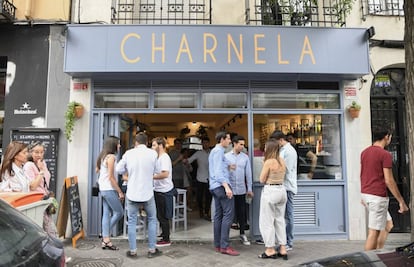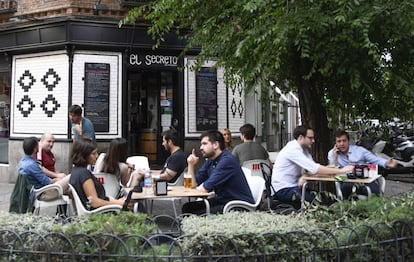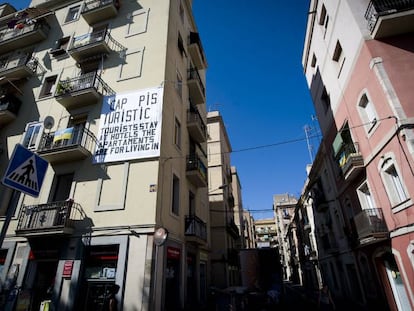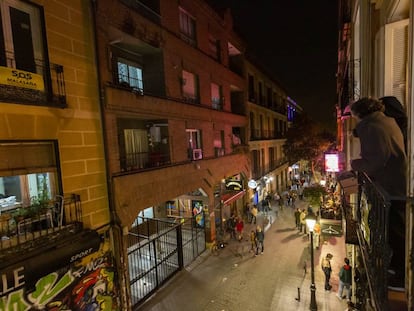Madrid’s “hottest street”: 72 bars packed into one kilometer
One out of every two commercial premises on Ponzano is either a drinks or food venue. Visitors love it, but local residents are desperate for solutions to the constant noise and crowds

This is the story of a residential street in Madrid that has morphed into a theme park. It is the hottest road in the capital according to Lonely Planet, whose guide to Madrid describes it as “lined with tapas bars and cocktail spots in Madrid’s Chamberí neighborhood, [which] has skyrocketed in recent years.”
One out of every two commercial premises along this one-kilometer stretch of the capital is a bar. No kidding: there are 72 in total. Back in 2008, bars constituted 34% of the street’s commercial activity, but now that figure stands at 49%. And they are open for business Monday through Sunday. Their success is such that there are lines outside some of these venues just to get a beer or a glass of wine.
The street we live in can’t be turned into a postcard or a theme park
Julio López de la Sen, El Organillo neighborhood association
But while the bars are bustling, the residents are bristling, fed up with the relentless noise. Parking space has also become a problem, not to mention the gentrification of the area and strategies by landlords to push out long-term tenants in favor of tourists. “The area is almost at breaking point,” says Julio López de la Sen, president of the neighborhood association El Organillo.
“The rise in bars is pushing out other local business and is going to end by pushing out the residents,” says López de la Sen. “It has happened gradually. We’ve been aware of it, but it has gotten out of control. It is hard to imagine the problems that ‘ponzaning’ brings.”
‘Ponzaning’ is a term coined a few years ago by area entrepreneurs to describe the activities of drinking, eating and having fun, which they defined as “a trend” and “a philosophy.” But Ponzano street wasn’t always synonymous with fashion. While Michelin-starred chef and MasterChef panelist Pepe Rodríguez possibly fueled its popularity in 2015 when he said: “Two of my favorite restaurants are on this street,” referring to El Doblado and Taberna Averías, the turning point for the neighborhood probably happened 10 years earlier when the restaurant Sudestada opened up here. Until then, Ponzano street was on the fringes of Madrid’s celebrated bar and restaurant scene. Almost instantly, Sudestada became a roaring success, with chef Estanis Carenzo receiving praise not only from clients but also from fellow chefs such as Dabiz Muñoz from DiverXo.

In 2013, the Academia de Despiece opened with its adjacent Sala de Despiece, which offered an innovative combination of dinner and gastronomy masterclass. Two years later, La Contraseña popped up and in July 2016, the street became absorbed into the local Fiestas del Carmen, consolidating its ‘hot’ reputation.
“The problem was obvious then,” says Pilar Rodríguez, 68, the district spokeswoman for the Socialist Party (PSOE) and a resident of 30 years in the area. Rodríguez can hear the noise on Ponzano from her home on Alonso Cano.
New bars
At first, the new bars were welcomed, and Rodríguez, a pharmacist, would be told by locals 15 years ago that it was a relief to see different businesses coming to the area. After all, this was a neighborhood with one of Madrid’s largest ageing populations. In fact, it still is – there are 220 residents over the age of 65 for every 100 under the age of 16. It is also the area with the most female residents: 78,140 women to 61,308 men. “Many years ago, Ponzano street needed an injection of life, but this is too much,” says Rodríguez, who also sits on the Board of Noise that was set up in 2015. “What we need now is some peace and quiet.”
Four years ago, a new bar was opening every two months, and there is now a watering hole every 15 meters. According to a report from the property consultancy Gesvalt, it has more bars and restaurants (49%) than Gran Vía (29%) and Fuencarral (13%). The phenomenon is one side of the coin, while the other is the closure of small retailers after decades of struggle. There has been a 3.5% decline in local business in the Madrid region since 2014, while the number of food and drink establishments has risen in the same period by 1.2%.
What we need now is some peace and quiet
Pilar Rodríguez, PSOE district spokeswoman
But the local mom-and-pop stores selling clothing, electronics or eyeglasses have more than bars to blame. For years they’ve been dealing with competition from shopping centers, with an aggressive liberalization of business hours, with rising rent, with the economic crisis, and most recently with the popularity of online sales.
Ponzano street is undergoing the same transformation as Malasaña and Chueca, with bars replacing local shops. Where there was once an antique store, there is now a trendy café, and instead of a bakery, there is a cocktail bar.
But on Ponzano street, even some of the original venues that triggered the trend have gone out of business, such as the iconic Sudestada, which shut in 2017. The most recent to go under is Lambuzo, which specialized in cuisine from Cádiz. The vacuum is quickly filled by chain restaurants and cocktail bars.
But a few of the smaller outfits continue to thrive, such as Charnela, whose owner Alejandro Yravedra specializes in cuisine using homegrown ingredients. Yravedra has long dreamed of setting up a food and drink business and invested all his savings in a street with a good future, the way he sees it. “There is a reason why important people with money are investing here,” he says.
According to the residents, these “important people” are investment funds and business groups such as Larrumba, Lalala and La Máquina. Many of the new establishments on Ponzano belong to these three corporations, their success fuelled by tourism, the economy and funds.
Alejandro Yravedra, Charnela owner
The acoustic angle
According to city bylaws, the only way an area can limit such licenses is if it is declared a Special Acoustic Protection Zone (ZPAE). There are currently three of these zones: the Center, Azca in Tetuán and Gaztambide in Chamberí. “Our idea was to create a protection model,” says Jorge García Castaño, a Madrid city councilor for the Chamberí district during the last term.
Last September the authorities started to measure noise levels in establishments in the area. But then it seemed as though the project ran out of steam, despite the fact the councilor recognizes the noise problem is being exacerbated the introduction of music bars with a disco feel.
“Traditional bars used to close at midnight. The existing ones stay open until 2am or 3am. And the new ones want to stay open until 6am,” says Julio López de la Sen from El Organillo neighborhood association. “The street we live in can’t be turned into a postcard or a theme park.”
“Ponzano has not only gone wild, there is also hardly anywhere left where you can get decent food,” says Rocío Borobia, a resident who owns a business premise here. “Many of the bars and restaurants do not even install vents anymore because they don’t cook,” she adds, referring to the fact that many bring in pre-cooked food that they simply reheat.
Rocío Borobia’s family first moved to Chamberí in 1953, when her grandparents took an apartment on the corner of Santa Engracia and Ponzano and set up a tobacco store, which later functioned as a stationers and a dry cleaner’s. Her mother subsequently turned it into a clothing shop, a business that Borobia herself became involved in. But keeping afloat was a struggle and, after 15 years, she decided to rent out the premises, though she would do so on her own terms. “There was no way I wanted someone setting up a bar there,” she says.
Months were spent looking for a tenant and studying a market that would give her between €6,000 and €10,000 a month in rent if she relented and rented to a bar or restaurant business – more than double any other activity.
“I am very critical about what is happening in the neighborhood, which is why I don’t want to add to its deterioration,” says Borobia, who finally let her place last December to a bookstore-stationers. “This district used to have a lot of businesses: hardware stores, bakeries, grocers… It’s an area with a lot of elderly people, and many of them spent their lives running these small businesses. But when they retire, their children either don’t want to continue with the business or can’t, because there is no money in it. So people rent out the premises or sell up without caring too much about what happens to it. But I do care about the area.”
Her solution? Don’t issue any more bar and restaurant licenses.
English version by Heather Galloway.
Tu suscripción se está usando en otro dispositivo
¿Quieres añadir otro usuario a tu suscripción?
Si continúas leyendo en este dispositivo, no se podrá leer en el otro.
FlechaTu suscripción se está usando en otro dispositivo y solo puedes acceder a EL PAÍS desde un dispositivo a la vez.
Si quieres compartir tu cuenta, cambia tu suscripción a la modalidad Premium, así podrás añadir otro usuario. Cada uno accederá con su propia cuenta de email, lo que os permitirá personalizar vuestra experiencia en EL PAÍS.
¿Tienes una suscripción de empresa? Accede aquí para contratar más cuentas.
En el caso de no saber quién está usando tu cuenta, te recomendamos cambiar tu contraseña aquí.
Si decides continuar compartiendo tu cuenta, este mensaje se mostrará en tu dispositivo y en el de la otra persona que está usando tu cuenta de forma indefinida, afectando a tu experiencia de lectura. Puedes consultar aquí los términos y condiciones de la suscripción digital.
More information

The battle against vacation rentals spreads beyond Madrid
Archived In
Últimas noticias
Tiger Woods turns 50: Will he continue playing on the PGA Tour or take a back seat?
The surreal journey of James Nnaji, the Barcelona youth player selected in the NBA Draft who ended up in the NCAA
Trump claims peace in Ukraine is near, but Moscow suggests otherwise
A survivor’s account of the Interoceanic Train accident: ‘We were scared because of the speed on the curve’
Most viewed
- Oona Chaplin: ‘I told James Cameron that I was living in a treehouse and starting a permaculture project with a friend’
- Reinhard Genzel, Nobel laureate in physics: ‘One-minute videos will never give you the truth’
- Sinaloa Cartel war is taking its toll on Los Chapitos
- Why the price of coffee has skyrocketed: from Brazilian plantations to specialty coffee houses
- Chevy Chase, the beloved comedian who was a monster off camera: ‘Not everyone hated him, just the people who’ve worked with him’









































